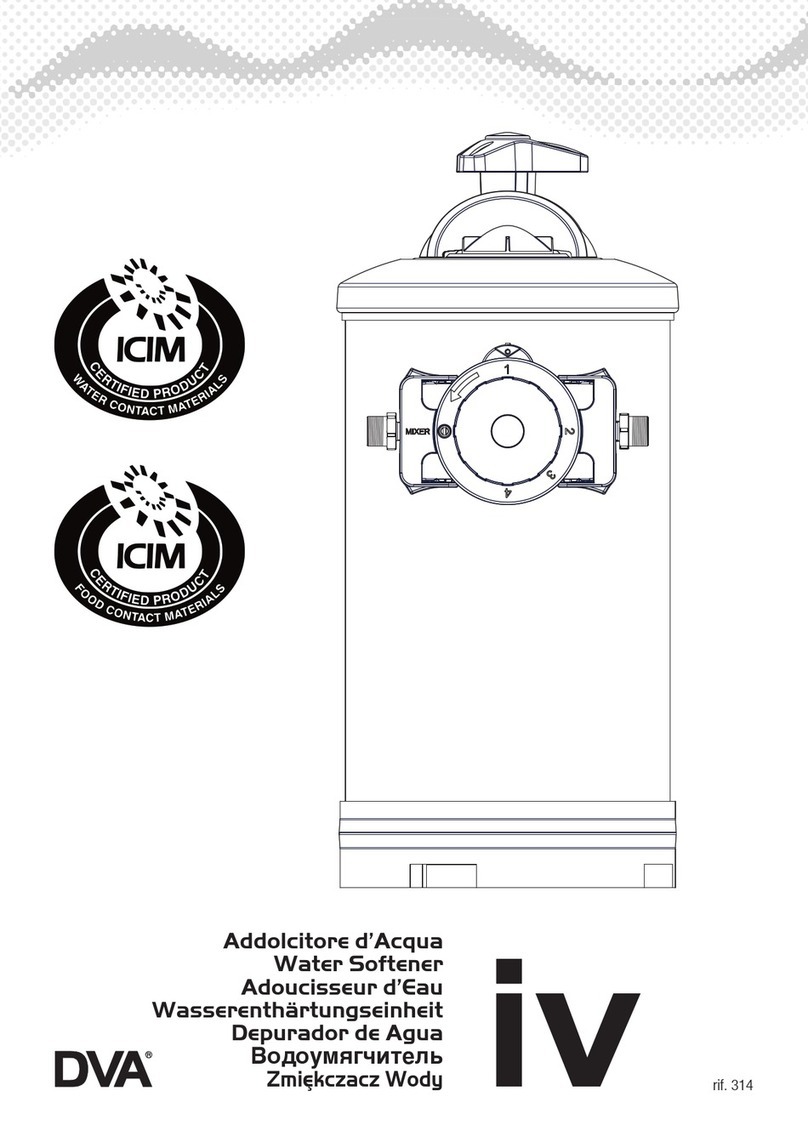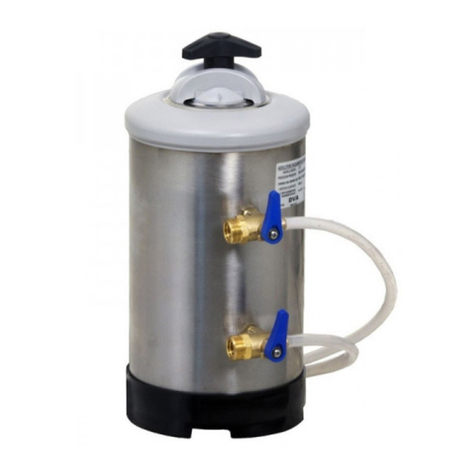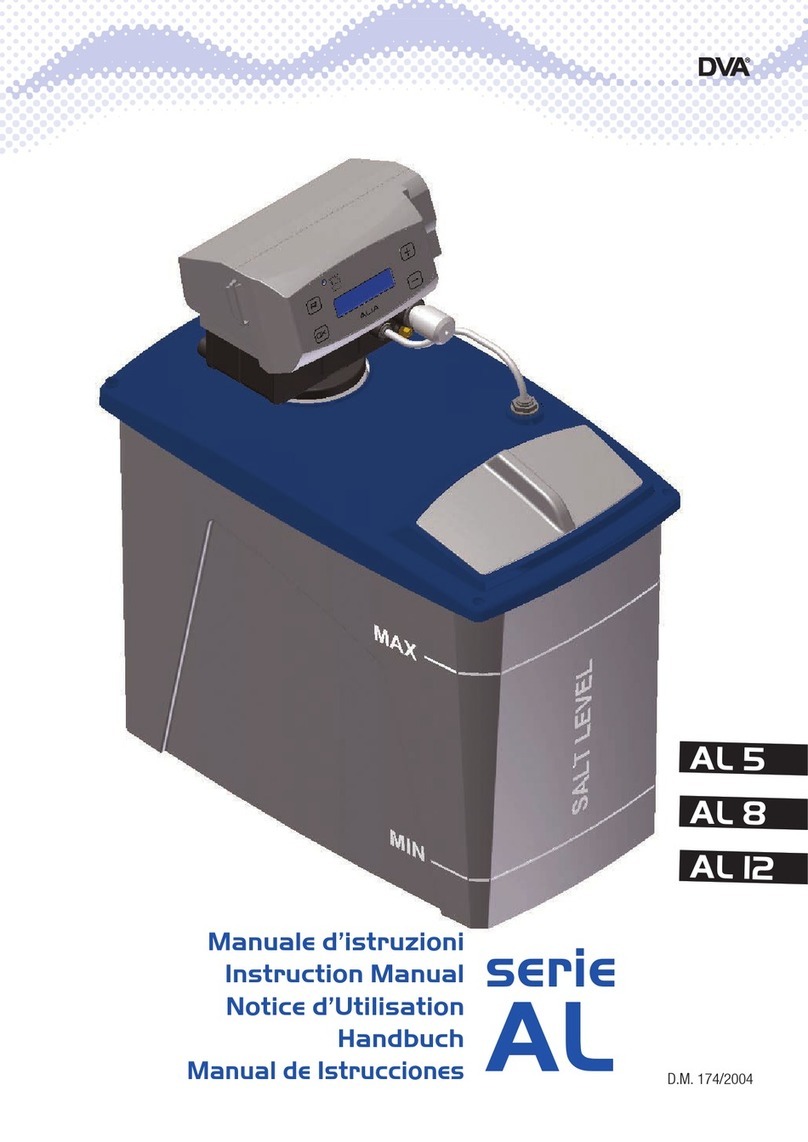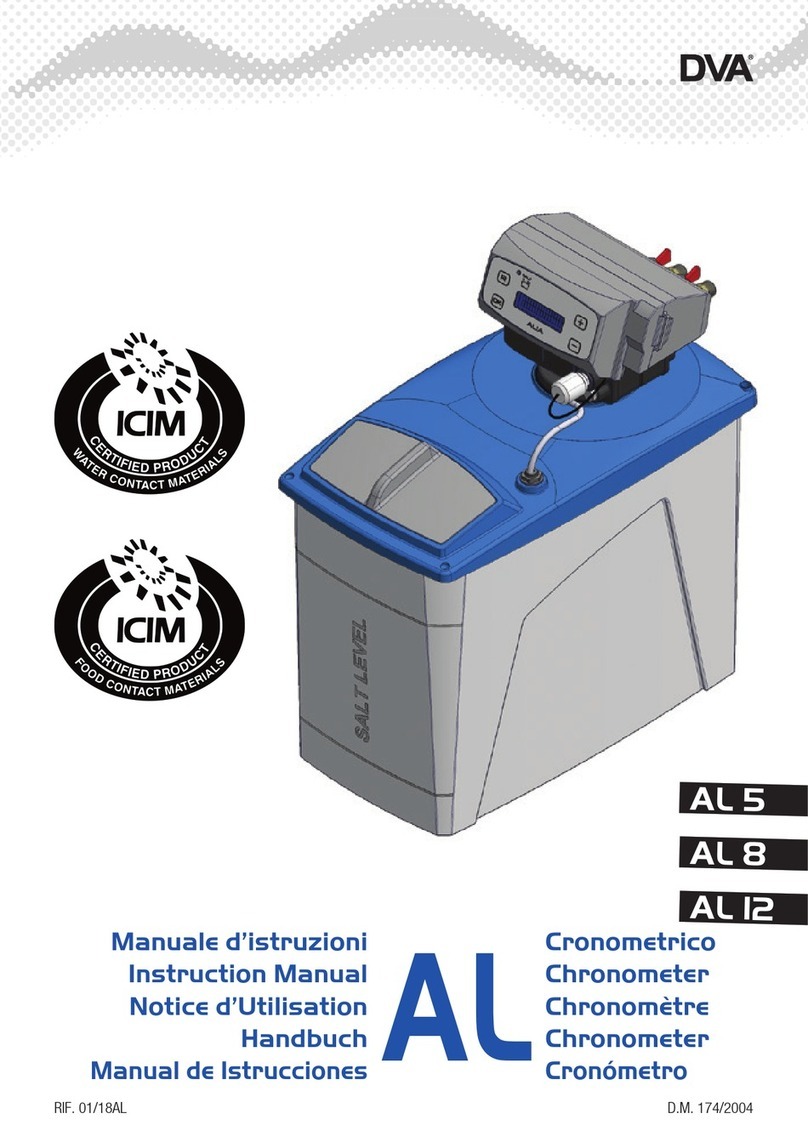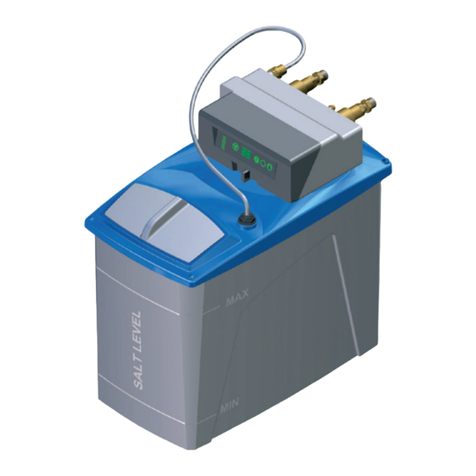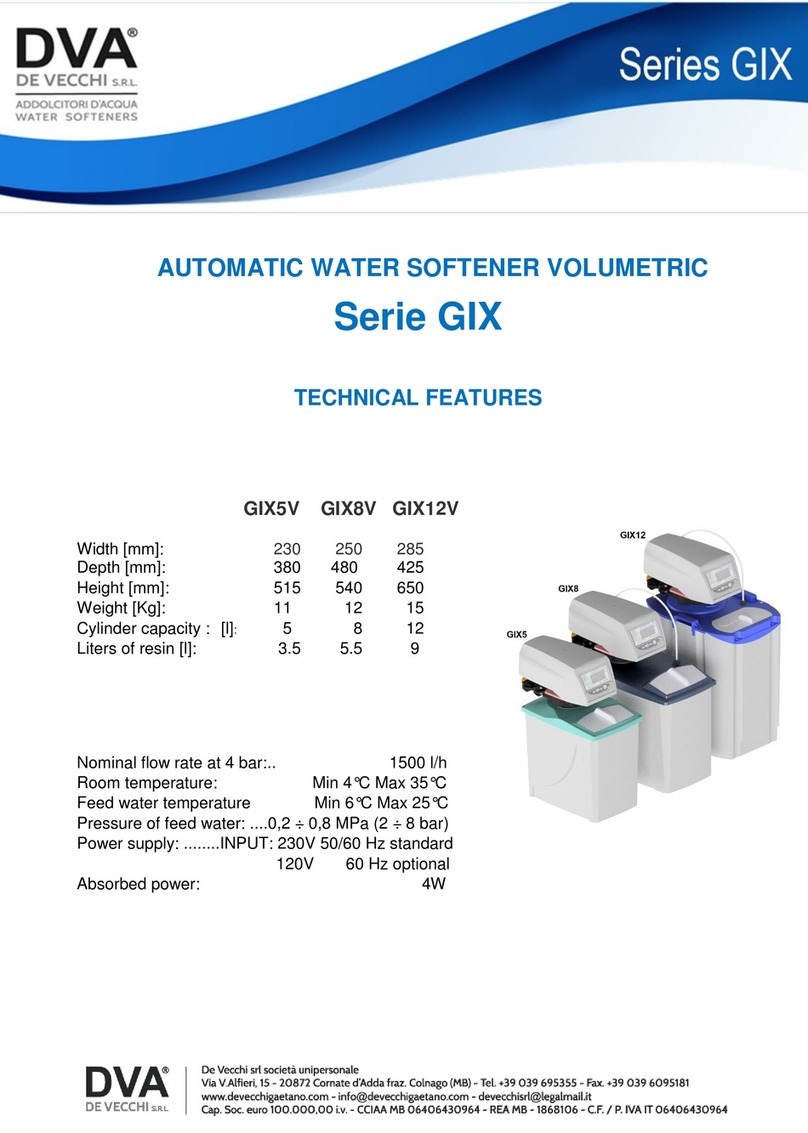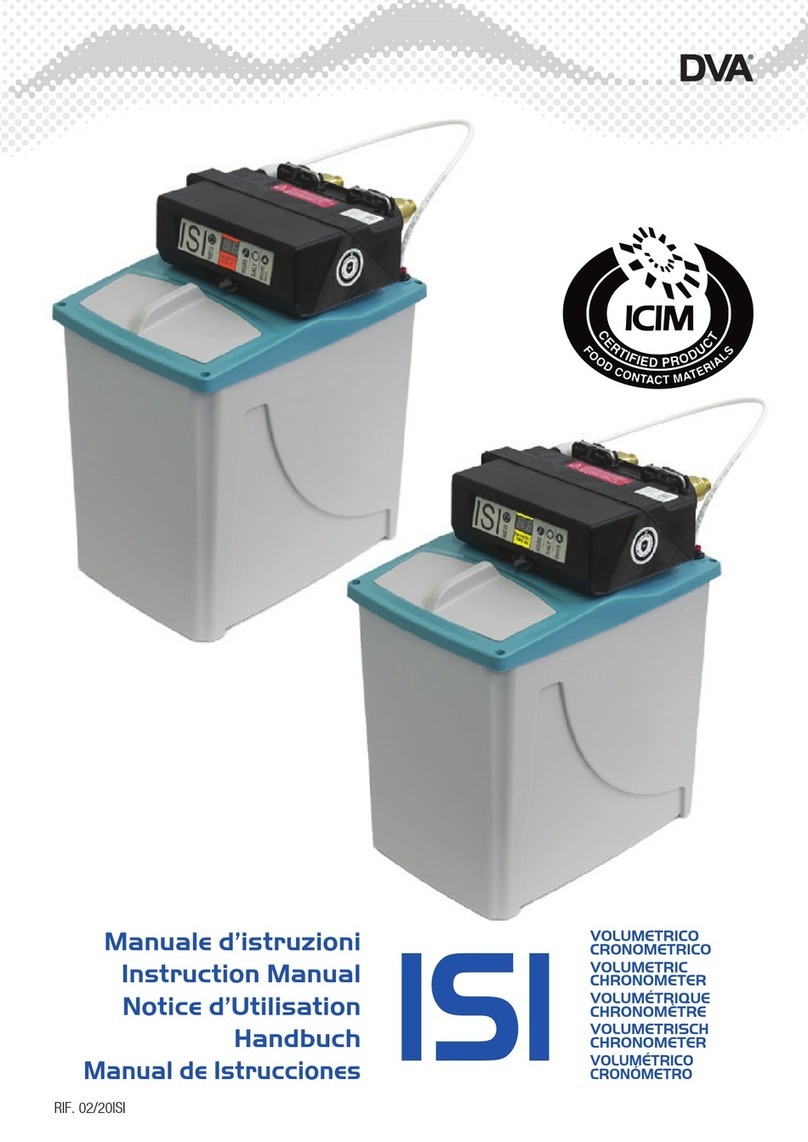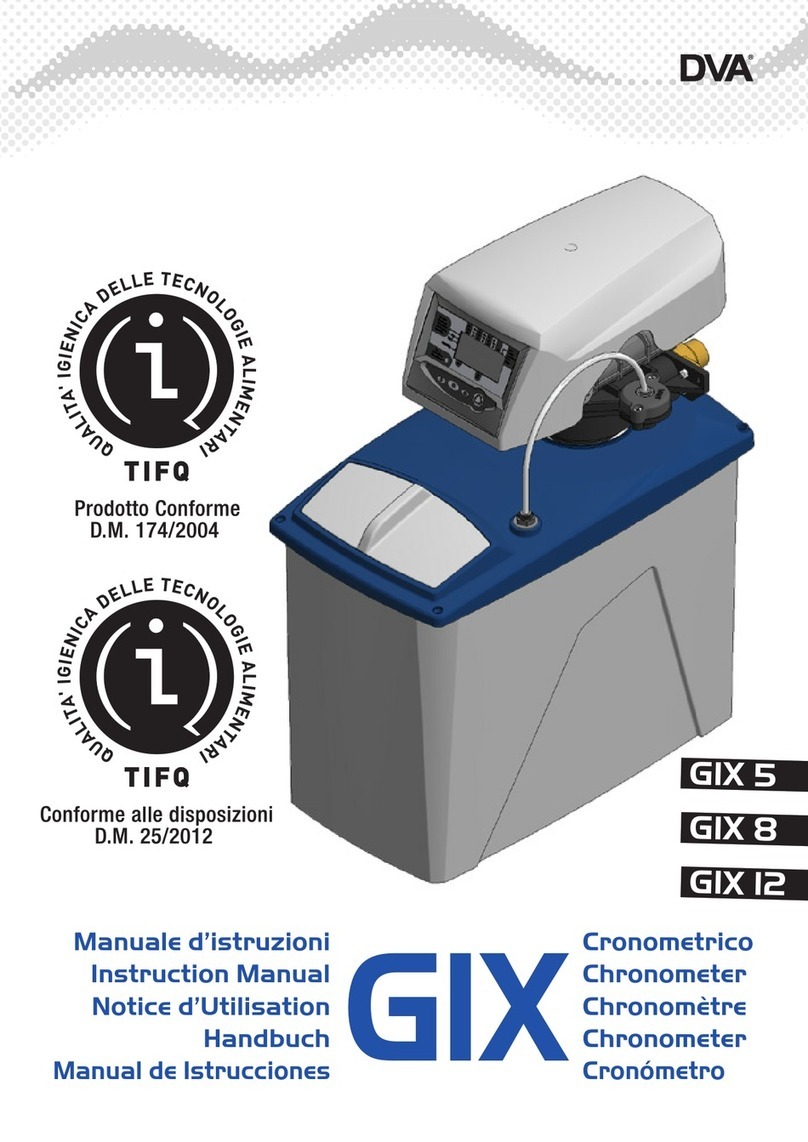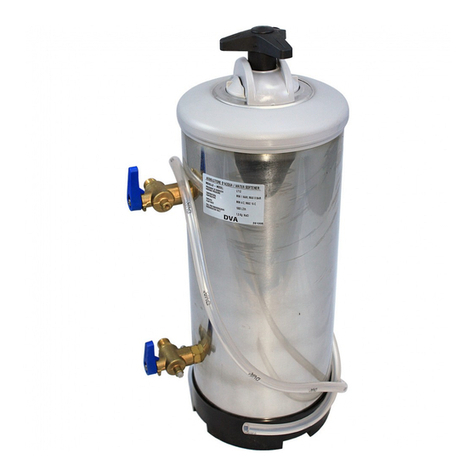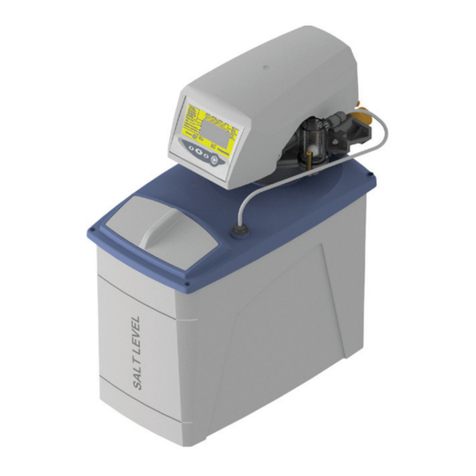
bonato di sodio, il quale è solubile in acqua alle temperature
normalmente presenti nelle macchine da caffè, nei produttori
di ghiaccio e nei distributori automatici di bevande.
La cessione continua di ioni sodio da parte delle resine, in-
dispensabili per l’addolcimento dell’acqua potabile, tende ad
esaurirsi in proporzione alla portata e al consumo dell’acqua
sino al loro esaurimento. È necessaria, quindi, la loro rigene-
razione effettuata per mezzo del passaggio di acqua e sale
da cucina attraverso le resine, riportando le stesse allo stato
attivo d’origine.
Le resine riducono gradualmente, in funzione del numero di
riattivazioni, la loro funzione cationica e conseguentemente
l’efficienza.
2.2 ADDOLCIMENTO DELL’ACQUA
Di seguito vengo elencate le reazioni chimiche principali che
caratterizzano lo scambio ionico che avviene durante il pro-
cesso di addolcimento dell’acqua tramite l’utilizzo delle resine
cationiche forti in forma NA+
Ca(HCO3)2 [bicarbonato di calcio] ---resina Na--- 2NaHCO3
Mg(HCO3)2
[bicarbonato di magnesio]
---resina Na--- 2NaHCO3
CaSO4[solfato di calcio] ---resina Na--- 2NaHSO4
MgSO4[solfato di magnesio] ---resina Na--- 2NaHSO4
CaCl2[cloruro di calcio] ---resina Na--- 2NaCl
MgCl2[cloruro di magnesio] ---resina Na--- 2NaCl
2.3 DESCRIZIONE DELL’ADDOLCITORE SERIE ER
L’addolcitore della SERIE ER è costituito da due componenti
che dovranno essere agganciati tra loro.
Il primo è la valvola ERV installata tra la rete idrica e la mac-
china da alimentare con acqua addolcita (fig. 2, A).
La valvola è innestata sulla bombola e fermata da due blocchi
laterali scorrevoli (fig. 2, C).
Il secondo è la bombola ER (fig. 2,B) intercambiabile. Unendo
la valvola con la bombola si forma l’addolcitore. Per garantire
il corretto funzionamento delle macchine alle quali l’addolci-
tore è applicato, occorre sostituire con regolarità la bombola
esausta con una rigenerata. Grazie alla rapida disconnessione
e alla pratica maniglia (fig. 2, F), sarà comodo rimuovere la
bombola per essere rigenerata dal tecnico dell’ assistenza.
Nota: Dopo 10 volte che la bombola viene rigenerata consi-
gliamo di sostituirla con una nuova.
La SERIE ER offre 8 modelli di diversa capacità:
ER5, ER8, ER10, ER12, ER14, ER16, ER18, ER20 (fig. 8).
2.4 DESCRIZIONE DELLA VALVOLA SERIE ERV
La valvola ERV collegata alla rete idrica, consente l’ingresso
dell’acqua nella bombola SERIE ER ed ha tre funzioni selezio-
nabili ruotando una manopola.
1. SERVICE (LAVORO), è la posizione in cui l’acqua passa
all’interno della bombola, va a contatto con le resine, viene
addolcita e poi mandata all’utenza (fig. 3).
2. REPLACE (SOSTITUZIONE DELLA BOMBOLA), è la po-
sizione di sostituzione dell’addolcitore (fig.4, A). L’acqua,
durante la sostituzione, viene erogata senza essere stata
addolcita.
3. WASH (CONTROCORRENTE), in questa funzione l’ac-
qua passa attraverso le resine, ma in direzione contraria,
uscendo dal tubo di scarico (fig. 5). In questa fase non va
acqua all’uscita.
La valvola è dotata di un miscelatore che permette di lasciare
un residuo di durezza nell’acqua in uscita dall’addolcitore
(vedi capitolo 5).
La valvola ERV può essere connessa a tutti i tipi di bombole
(fig.8).
2.5 LA SCATOLA DELLA VALVOLA ERV CONTIENE
• 1 valvola ERV
• 1 libretto d’istruzioni
• 1 tubo per lo scarico
• 2 raccordi da 3/8”G o da 3/4”G (fig.6, C) per collegare la
valvola alla macchina da alimentare
• 1 rubinetto d’ingresso da 3/8”G o da 3/4”G (fig.6, E) per
collegare la valvola alla rete idrica
2.6 LA SCATOLA DELLA BOMBOLA CONTIENE
• 1 bombola SERIE ER (fig. 1)
• 1 libretto di istruzioni
2.7 CARATTERISTICHE TECNICHE
Portata nominale a 4 bar..... 800 l/h
Temperatura ambiente:...... 4°C - 35°C
Attacchi allacciamento idrico: . 3/8”G; 3/4”G
• Caratteristiche dell’acqua d’alimento:
- l’acqua d’alimento deve essere potabile e limpida
- temperatura: 6°C÷ 25°C
- pressione: 0,1 MPa ÷ 0,8 MPa (1 ÷ 8 bar)
- durezza massima: 900 ppm (90°f)
2.8 QUANTITÀ D’ACQUA ADDOLCITA
Nella tabella n.1 è indicata la quantità d’acqua addolcita che
ER è in grado di erogare, a secondo del modello, prima di
essere rigenerato.
La quantità d’acqua che ogni addolcitore è in grado di ero-
gare, varia in base alla sua durezza e alle dimensioni delle
bombole.
Sono inoltre indicati quanti caffè e tea si possono erogare con
le diverse bombole.
Per esempio: se una bombola ER8 dovrà addolcire un’acqua
di durezza pari a 30°f, erogherà 1120 litri pari a 33600 caffè
o 11200 tea.
3) INSTALLAZIONE
3.1 IMBALLO
• Prima dell’installazione accertarsi che la valvola e la bom-
bola non presentino anomalie o danni causati dal trasporto;
nel dubbio rivolgersi al rivenditore.
• Conservare per qualche tempo la scatola dell’imballo aven-
do cura di non lasciare pezzi dell’imballo pericolosi o piccoli
alla portata dei bambini.
3.2 SCELTA DEL LUOGO PER L’INSTALLAZIONE
• Verificare se a monte del punto di installazione dell’appa-
recchio non sia già presente un qualunque sistema di tratta-
mento.
• Verificare che il prelievo dell’acqua avvenga da una tubazio-
ne dove scorre acqua potabile. Si consiglia di effettuare una
verifica dei parametri chimico-fisici e durezza dell’acqua
potabile in ingresso prima della installazione.
• Installare l’apparecchio in un luogo asciutto e facilmente
accessibile per le operazioni di manutenzione, sostituzione
e pulizia; non installare la valvola in posti sporchi dove man-
chino i principi di igienicità o in cui sia difficile fare pulizia.
• Non installare in ambienti in cui c’è un evidente violazione
delle norme di sicurezza elettrica o antinfortunistica e/o igie-
nica.
• Verificare che la temperatura dell’ambiente sia compresa
tra 4°C e 35°C.
• Tenere lontano dai prodotti acidi o corrosivi.
La pressione idrica non deve essere inferiore a 0.1 Mpa (1
bar) o superiore a 0.8 Mpa (8 bar) (si consiglia almeno 3 o
Manuale d’istruzioni ADDOLCITORE ER e VALVOLA ERV 7
ITALIANO
manuale
d’istruzioni
ADDOLCITORE ER e VALVOLA ERV






